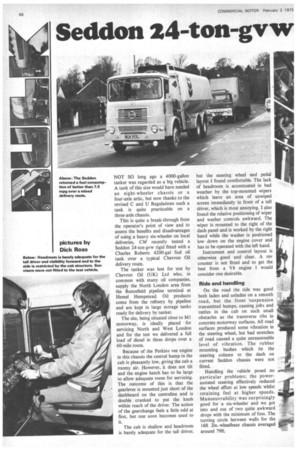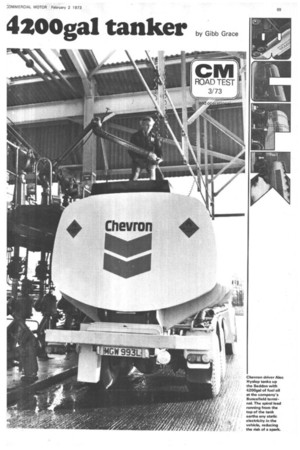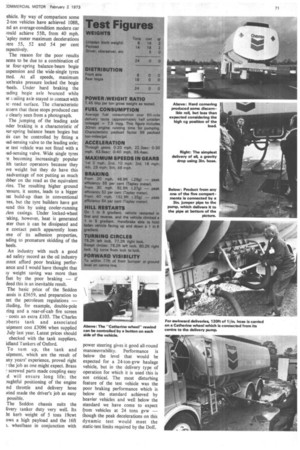Seddon 24-Enton-gvw
Page 70

Page 71

Page 72

Page 73

If you've noticed an error in this article please click here to report it so we can fix it.
4200ga1 tanker by Gibb Grace
NOT SO long ago a 4000-gallon tanker was regarded as a big vehicle. A tank of this size would have needed an eight-wheeler chassis or a four-axle attic, but now thanks to the revised C and U Regulations such a tank is quite practicable on a three-axle chassis.
This is quite a break-through from the operator's point of view and to assess the benefits and disadvantages of using a heavy six-wheeler on local deliveries, CM recently tested a Seddon 24-ton-gvw rigid fitted with a Charles Roberts 4200-gal fuel oil tank over a typical Chevron Oil delivery route. The tanker was lent for test by Chevron Oil (UK) Ltd who, in common with many oil companies, supply the North London area from the Buncefield pipeline terminal at Kernel Hempstead. Oil products come from the refinery by pipeline and are kept in large storage tanks ready for delivery by tanker. The site, being situated close to MI motorway, is ideally placed for servicing North and West London and for the test we delivered a full load of diesel in three drops over a 60-mile route.
Because of the Perkins vee engine in this chassis the central hump in the cab is pleasantly low, giving the cab a roomy air. However, it does not tilt and the engine hatch has to be large to allow adequate room for servicing. The outcome of this is that the gearlever is mounted just short of the dashboard on the centreline and is double cranked to put the knob within reach of the driver. The action of the gearchange feels a little odd at first, but one soon becomes used to it.
The cab is shallow and headroom is barely adequate for the tall driver, but the steering wheel and pedal layout I found comfortable. The lack of headroom is accentuated in bad weather by the top-mounted wipers which leave an area of unwiped screen immediately in front of a tall driver, which is most annoying. I also found the relative positioning of wiper and washer controls awkward. The wiper is mounted to the right of the dash panel and is worked by the right hand while the washer is positioned low down on the engine cover and has to be operated with the left hand.
Instrument and control layout is otherwise good and clear. A rev counter is not fitted and to get the best from a VS engine I would consider one desirable.
Ride and handling On the road the ride was good both laden and unladen on a smooth road, but the front suspension transmitted bumps, causing jolts and rattles in the cab on such small obstacles as the transverse ribs in concrete motorway surfaces. All road surfaces produced some vibration in the steering wheel, but bad stretches of road caused a quite unreasonable level of vibration. The rubber mounting bushes which tie the steering column to the dash on current Seddon chassis were not fitted.
Handling the vehicle posed no particular problems; the powerassisted steering effectively reduced the wheel effort at low speeds whilst retaining feel at higher speeds. Manoeuvrability was surprisingly good for a six-wheeler and we got into and out of two quite awkward drops with the minimum of fuss. The turning circle between walls for the 16ft 2in.-wheelbase chassis averaged around 79ft. The tank is made from 10-gauge mild steel and is sub-divided into five compartments — three at 1000 gal, one at 700 gal and one at 500 gal. The compartments make the scheduling of different size orders relatively easy and also stop any surge of the load on the road. Fore and aft movement laden or part laden was unnoticeable, and roll — though more evident than on a flat vehicle — was no worse than many boxvans and caused no problems.
Perfomtance results Fuel consumption over a 60-mile route which included 15 miles of motorway and moderate North and West London traffic worked out at 7.5 mpg. This average consumption does not take into account the fact that the engine ran fOr an additional 30 minutes to power the discharge pump. The fuel used during discharge was not measured but obviously was a significant amount. As little as half a gallon used on pumping would have put the over-the-road consumption up to 8.0 mpg which, considering the route and the fact that roughly half the route was covered unladen, about average.
On the following day a drive fro' the Buncefield terminal to MIRA vi MI and AS produced an average fu consumption of 7.5 mpg with tl vehicle fully laden.
The climb up from the Southei A5 junction reduced speed to minimum of 23 mph and the Watfoi Gap "Slow Lorries" gradient reduc( speed to 27 mph. Top speed on tl level was about 48 mph and ti average speed from Hemel Hem stead to the Northern A5 junctic worked out at only 41.1 mph.
On the flat one-mile straight at tl MIRA test track the Seddon achiev( only 95.4 sec. for 0-40 mi acceleration which is not only sic for a 24-ton six-wheeler, but also f a 32-ton artic.
The braking tests were even mo disappointing. On a dry surface t.1 Seddon took 46ft 10in, to stop fro 20 mph, 82ft 6in. to stop from : mph and 152ft Sin. from 40 mp These figures are well below avera for 24-ton-gvw vehicles and would considered poor for a 32-ton-gi,
chicle. By way of comparison some 2-ton vehicles have achieved 108ft, nd an average-condition modern car /could achieve 55ft, from 40 mph. 'apley meter maximum decelerations fere 55, 52 and 54 per cent espectively.
The reason for the poor results terns to be due to a combination of le four-spring balance-beam bogie uspension and the wide-single tyres tted. At all speeds, maximum )otbrake pressure locked the bogie 'heels. Under hard braking the !ading bogie axle bounced while tetailing axle stayed in contact with ic. road surface. The characteristic auern that these stops produced can e clearly seen from a photograph.
The jumping of the leading axle nder braking is a characteristic of sur-spring balance beam bogies but us can be controlled by fitting a lad-sensing valve to the leading axle; ie test vehicle was not fitted with a lad-sensing valve. Wide single tyres T becoming increasingly popular ith tanker operators because they we weight but they do have this sadvantage of not putting as much ibber on the road as the equivalent vins. The resulting higher ground .essure, it seems, leads to a bigger at build-up than in conventional res, but the tyre builders have got Rind this by using cooler-running ,Ion casings. Under locked-wheel -aking, however, heat is generated ster than it can be dissipated and e contact patch apparently loses 'me of its adhesion properties, ading to premature skidding of the heels.
An industry with such a good lid safety record as the oil industry Lnnot afford poor braking perforance and I would have thought that ty weight saving was more than fset by the poor braking — if deed this is an inevitable result.
The basic price of the Seddon .assis is £5659, and preparation to eet the petroleum regulations — :luding, for example, double-pole ring and a rear-of-cab fire screen costs an extra £103. The Charles 3berts tank and associated uipment cost £3096 when supplied July last year. Latest prices should checked with the tank suppliers, idland Tankers of Oxford.
To sum up, the tank and uipment, which are the result of my years' experience, proved right the job as one might expect. Brass screwed parts made coupling easy d will ensure long life; the xightful positioning of the engine nd throttle and delivery hose wind made the driver's job as easy possible.
The Seddon chassis suits the livery tanker duty very well. Its ht kerb weight of 5 tons 19cwt ows a high payload and the 1611 1. wheelbase in conjunction with power steering gives it good all-round manoeuvrability. Performance is below the level that would be expected for a 24-ton-gvw haulage vehicle, but in the delivery type of operation for which it is used this is not critical. The most disturbing feature of the test vehicle was the poor braking performance which is below the standard achieved by heavier vehicles and well below the standard we have come to expect from vehicles at 24 tons gvw — though the peak decelerations on this dynamic test would meet the static-test limits required by the DoE.
















































































































































